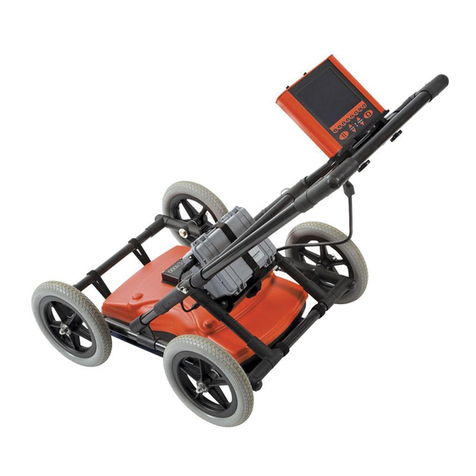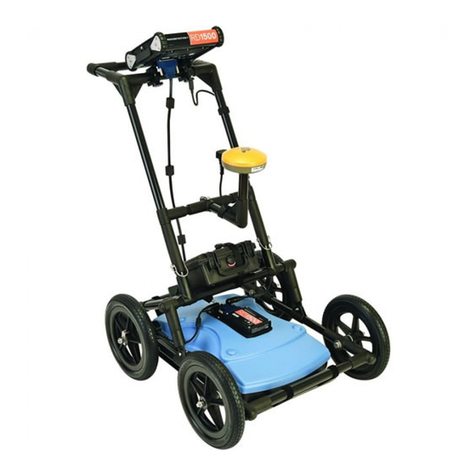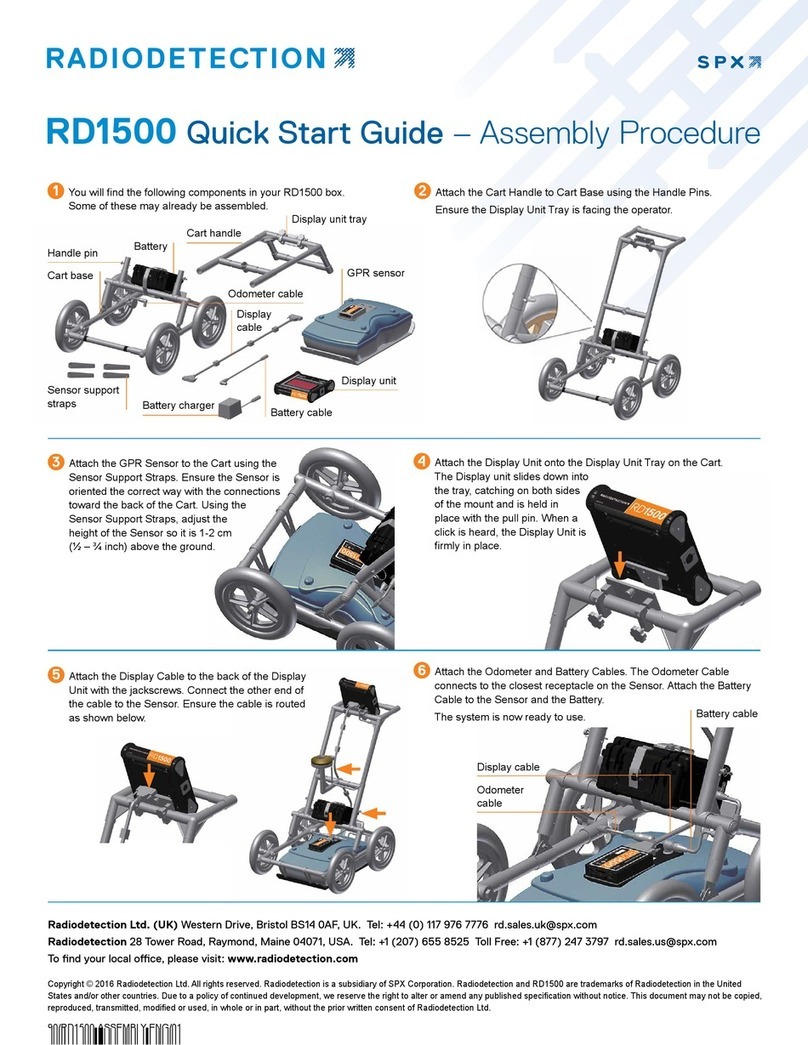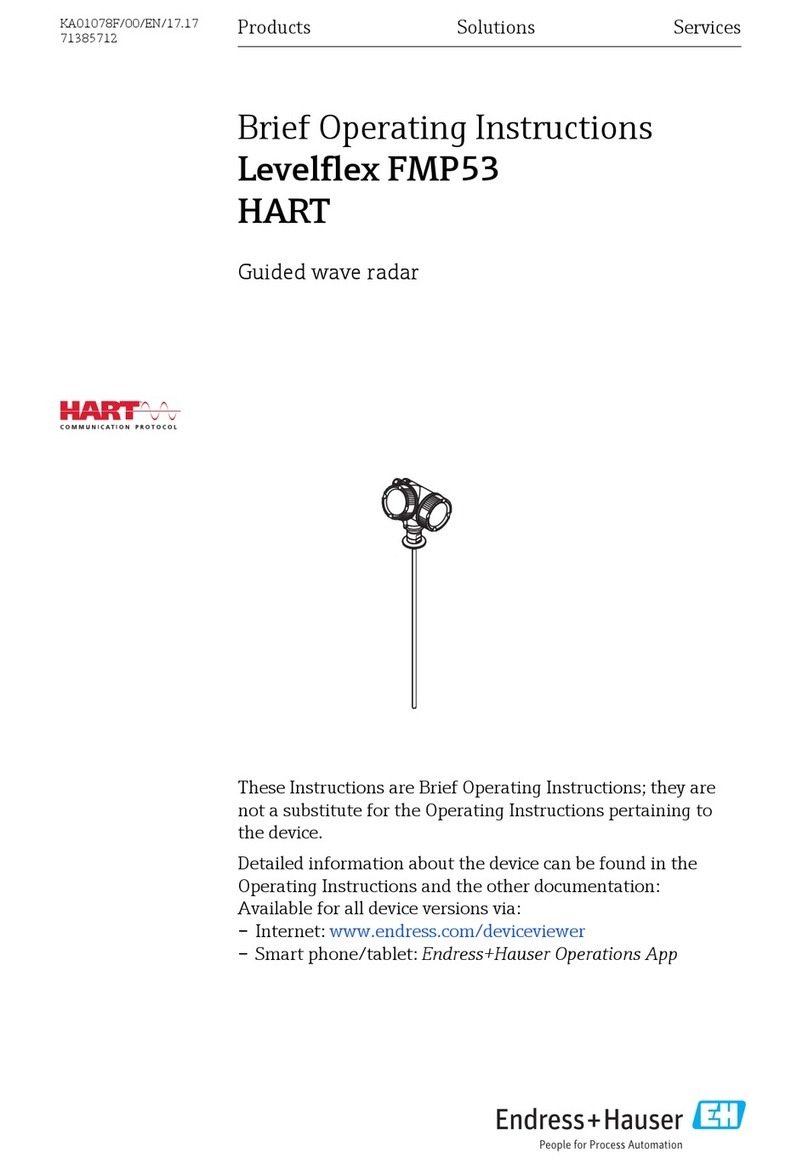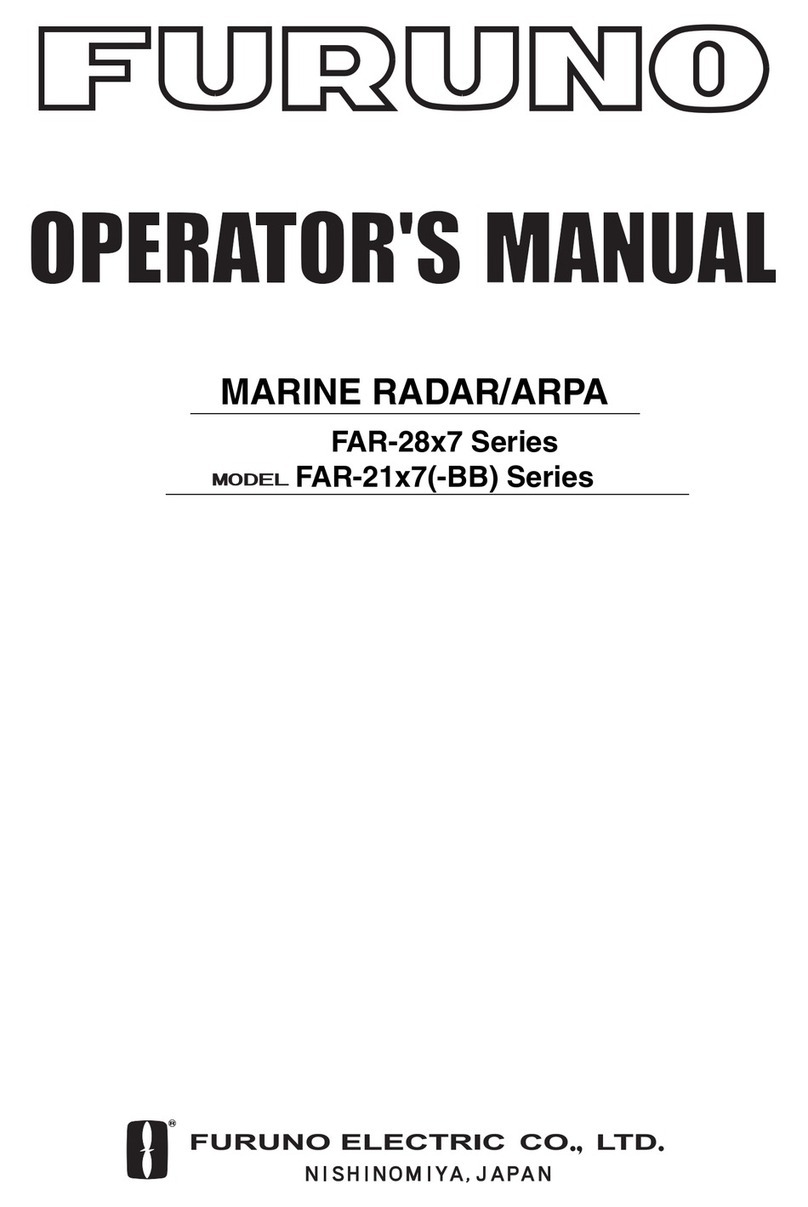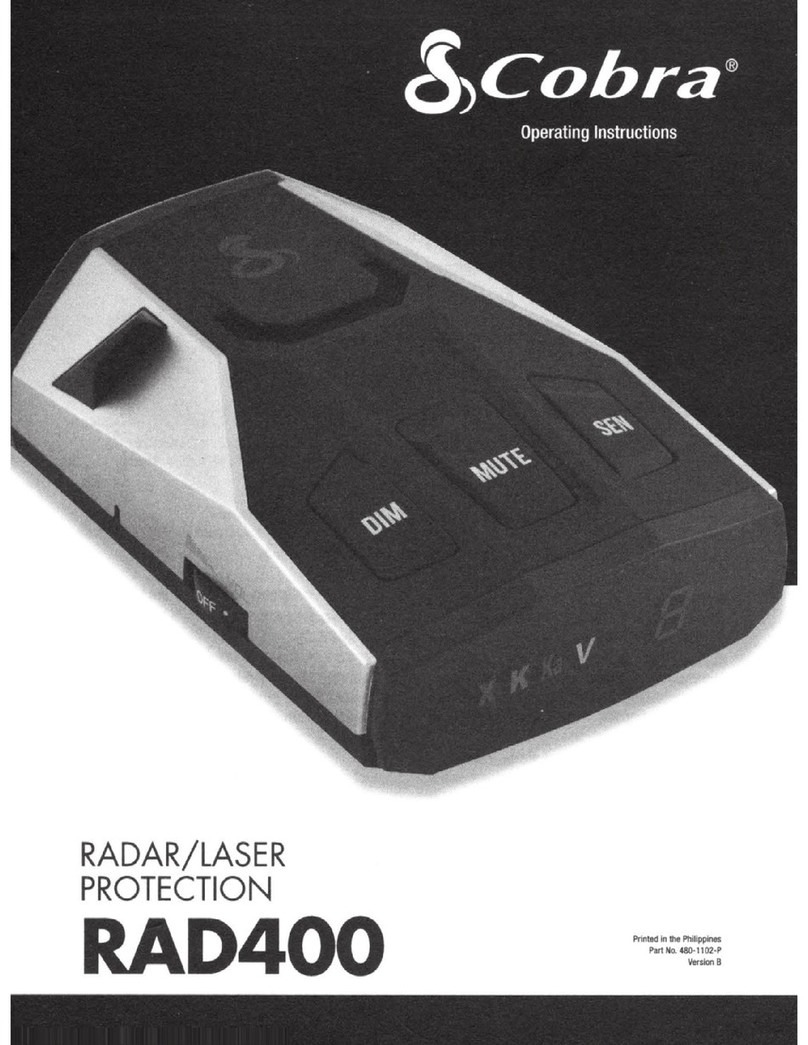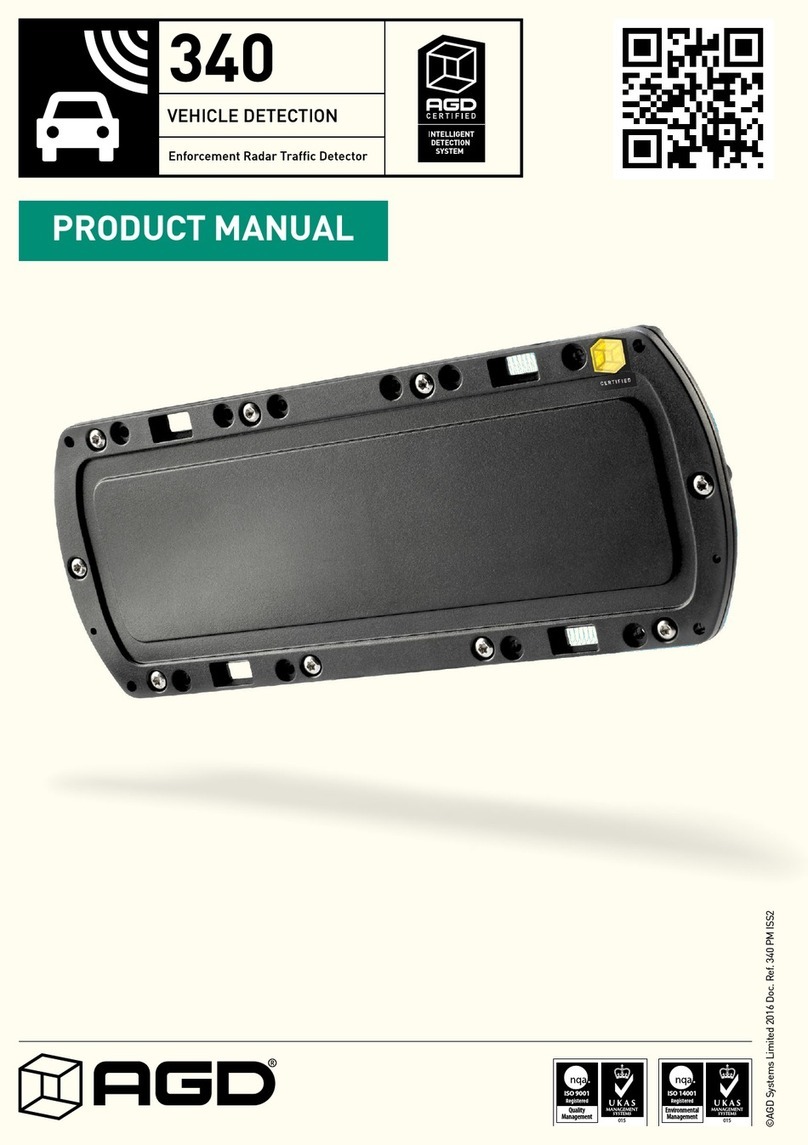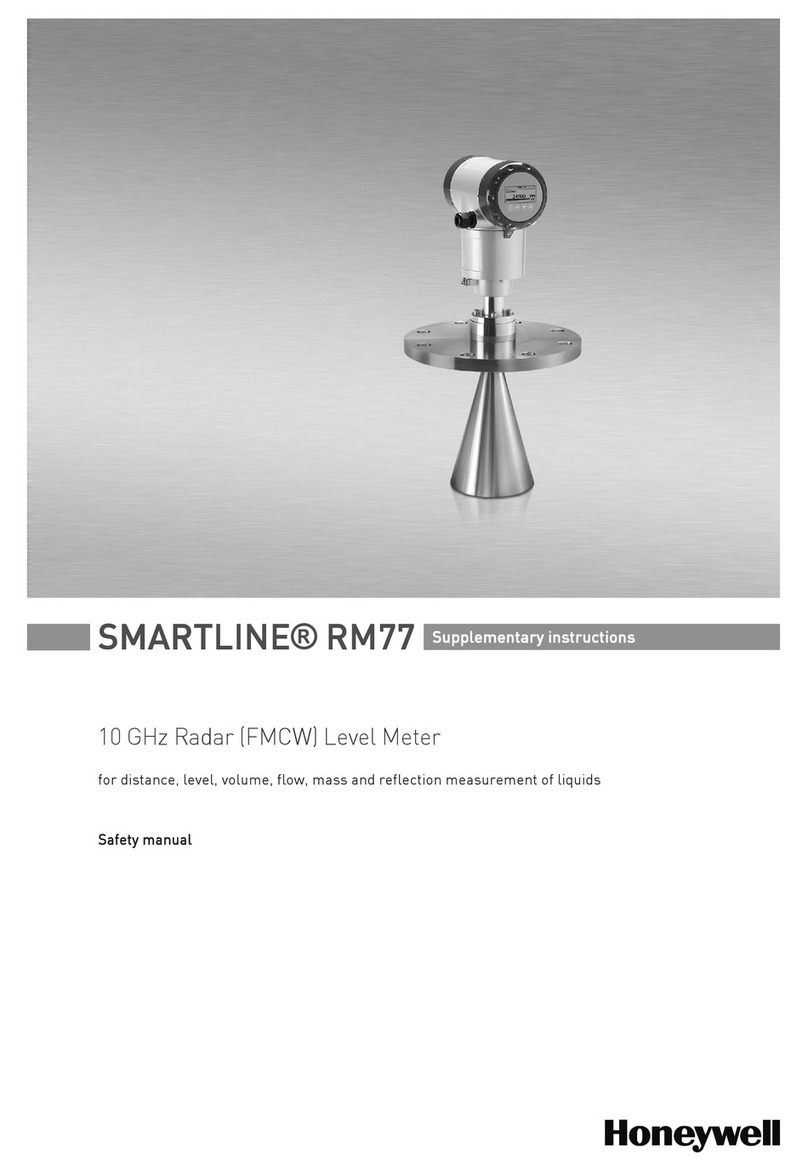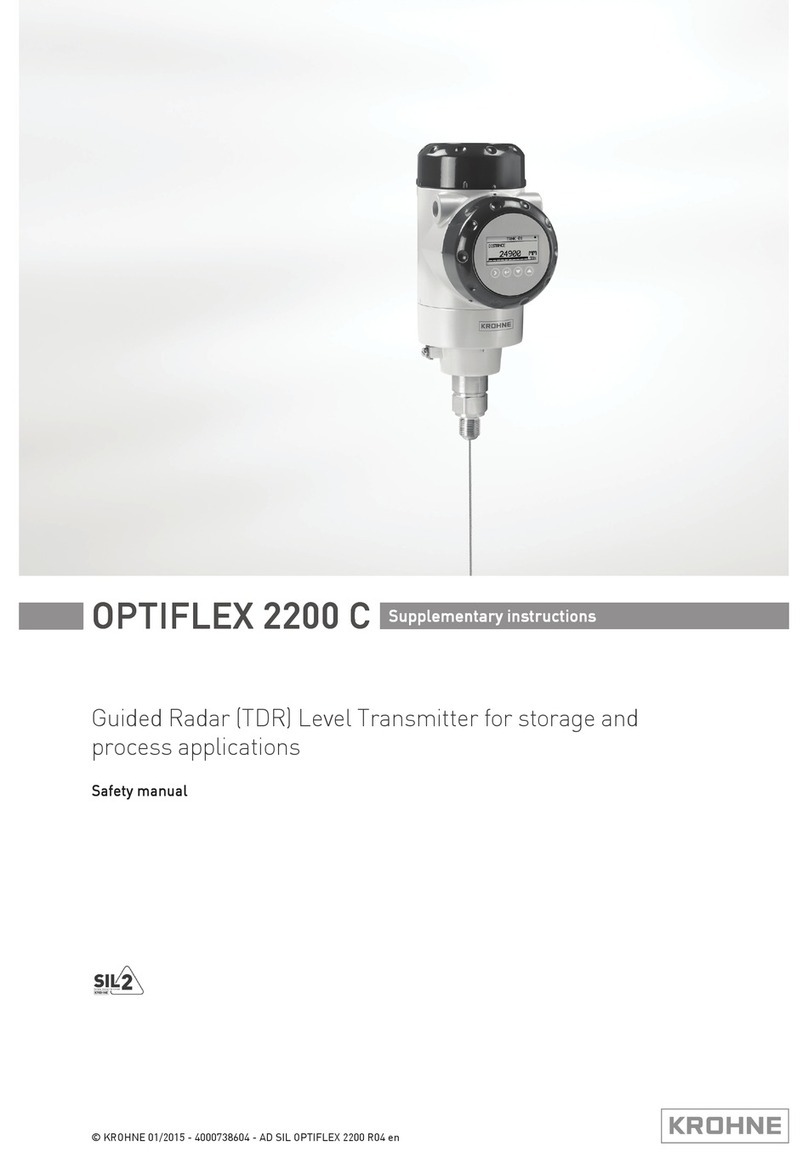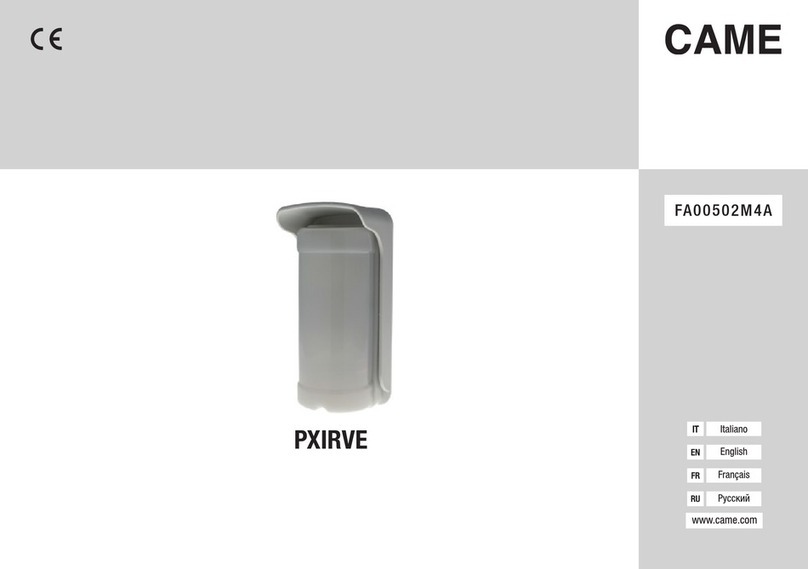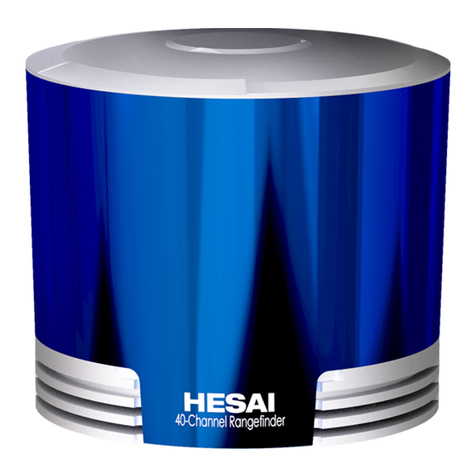Radiodetection RD500 User manual

RD500
Water pipe locator system
Quick start guide
90/UG117IMP/01

3
Introduction
About this guide
This guide provides basic operating instructions for the RD500 water pipe locator
system and is intended as a portable reference only. It also contains important safety
information and guidelines. As such, it should be read in its entirety before attempting
to operate the RD500. For detailed instructions, including the use of accessories,
please refer to the RD500 operation manual which is available for download from
www.radiodetection.com.
Radiodetection products, including this manual, are under continuous development.
The information contained within is accurate at time of publication; however the RD500,
this manual and all its contents are subject to change.
Radiodetection Limited reserves the right to modify the product without notice and some
product changes may have taken place after this user manual was published.
Unpacking and set-up
Your RD500 Plastic pipe Locator comes packaged in a special carrying case that has
compartments for the Plastic pipe Locator with spike installed, a hard surface plate and
the headphones. Each kit that you order is pre-assembled and ready for use. Please
keep all packaging materials in case it becomes necessary for you to return any of your
equipment. The following items should be checked as you unpack your system.
1. RD500 Plastic Pipe Locator: The Plastic Pipe Locator is supplied with a 9-volt
battery and ground spike installed. A hard surface plate and headphones are also
included along with this operation manual. If any items are missing please contact
your local Radiodetection oce.
2. Mechanical Pulse Transmitter: The Mechanical Pulse Transmitters are supplied
either as a stand-alone unit or as part of one of the RD500 Plastic Pipe Locator
Kits. In order to connect a Mechanical Pulse Transmitter, you will need a hose
adapter kit, which contains all the necessary connectors. If you buy one of the
RD500 Kits then all the connectors are supplied.
3. RD500-Tx Electronic Pulse Transmitter: Supplied fully assembled and ready
for use, with all necessary adaptors and hoses for connection to a low pressure
(Sub 4 bar) water supply. If any items are missing please contact your local
Radiodetection oce.

4
Quick start guide
Pulse Transmitter operating instructions
(red, yellow and green Pulse Transmitters)
1. Remove protective caps from Pulse Transmitter.
2. Connect Pulse Transmitter to nearest water outlet and drain
using the correct hose connector kit.
3. Turn on water and loosen adjustment lock nut near T-handle.
4. Turn T-handle clockwise until water ows.
5. Turn T-handle counter-clockwise until water pulses several times
per second; tighten lock nut.
RD500-Tx Electronic Pulse Transmitter operating
instructions
1. Best connected via the supplied adaptor kit.
2. Connect the Pulse Transmitter via the damper
hose and tap adaptors to the incoming water
supply. The arrow on the Pulse Transmitter
indicates the ow of water.
3. Connect the Pulse Transmitter to the power supply.
4. Connect the outlet hose as shown, this will provide the BACK
PRESSURE needed to operate the Pulse Transmitter eectively.
Turn on the water and discharge into a drain or similar.
• Turn on the Pulse Transmitter power pack The Pulse Transmitter will start to
PULSE and water will start to ow through the hose.
• You can now locate the pulse from underground using the RD500 receiver in
the usual way.
• If the battery light ashes, then change the batteries.

5
RD500 Plastic Pipe Locator operating instructions
1. Turn ON/OFF knob clockwise to activate.
2. Initial meter reading indicates battery condition.
3. To replace battery, loosen battery release button, move housing upward to
expose battery.
4. Begin initial tracing about 6 feet from the Pulse Transmitter or any other
area where pipe location is known.
5. Push spike of Plastic pipe Locator into ground near known pipe location
and turn ON/OFF knob clockwise for mid-range meter reading. Starting
with the headphone volume sensitivity at a low level, adjust the controls for
comfortable listening level. Each earpiece has its own adjustment.
6. To pinpoint pipe position, use Plastic pipe Locator to probe ground until you
nd peak (maximum) meter reading. You will also hear the pulsing sound
(similar to a heartbeat) grow louder.
7. Trace the pipe by establishing the direction of pipe route by probing every
3 to 6 feet to locate a peak meter reading. Adjust the ON/OFF knob to
maintain a mid-range meter reading.
Notes and Precautions
• The RD500 is for use on water pipes only.
• It works best on water pressures in the range of 3 to 7 bar, (44 to 100psi);
maximum pressure 10 bar, (145psi).
• The Pulse Transmitter pulsating eect causes pipe movement. If used for
extended periods or on substandard plumbing systems, leaks may result. We
recommend using the short tap damper hose to reduce strain on pipe ttings,
notably push t domestic connections.
• RD500 readings do not indicate depth and the RD500 does not detect buried
electrical power lines, gas lines or other hazardous underground objects, so
always dig carefully in the proximity of buried pipes or cables.
• Use caution while wearing headphones and be alert to trac or other hazards that
are normally heard outdoors.
• Always stand clear of all Pulse Transmitters, adapter kits and hoses while they are
connected to water systems and operating. Ensure the drain hose is secured with
a heavy object.
• On all hose bib applications, within 50 feet of a building, the proper low-power Pulse
Transmitter (GREEN) or RD500-Tx, and tap damper MUST be used.

6
Pulse Transmitter application techniques
Pulse Transmitters are connected at sprinkler heads, hose bibs, water meter bases,
re hydrants and clean-outs. Supplied Pulse Transmitter adapter kits are illustrated
later in this manual. Always ush any connection site until the water that ows is clear
of all rust, silt, sealing compounds and foreign materials before connecting a Pulse
Transmitter to the water line. If necessary clean all pipes, hoses and equipment with an
appropriate sterilising solution.
All adapter kits are supplied with a 10 foot high-pressure drain hose that must be
connected to the outlet of the Pulse Transmitter in order for the device to work
properly. Always use a weight on the hose or tie the hose down to prevent the hose
from whipping.
Check the water pressure before attempting to locate the water line and make sure that
it is in the operating range of the Pulse Transmitter, which is 3 to 10 bar (40 to 145 psi)
for the coloured brass Pulse Transmitters or up to 4 Bar for the RD500-TX electronic
Pulse Transmitter.
The Pulse Transmitters are color-coded to identify their intended usage: A color-coded
ty-wrap is used along with a small square area that is painted on the side of the Pulse
Transmitter to indicate the color. Green is the lowest power Pulse Transmitter and
is intended for use on sprinkler and hose bib pipes that typically range in diameter
between 0.5 inches and 2 inches. Green Pulse Transmitters may be may be used
on larger diameter pipes where reduced operating range is acceptable. Yellow Pulse
Transmitters are intended for use on water mains that range in diameter between 2
inches and 6 inches.They are typically connected at a water meter connection. Yellow
Pulse Transmitters should never be used on smaller diameter pipes, but they may be
used on larger diameter pipes. Red Pulse Transmitters are intended for use only on
water mains that are 6 inches in diameter or larger. The typical connection is via a re
hydrant.
The RD500-Tx electronic Pulse Transmitter is best used on domestic supplies where
the pressure does not exceed 4 Bar.
When using a Mechanical Pulse Transmitter, always start your adjustments by turning
the T-handle clockwise until full water ow is attained at the Pulse Transmitter outlet.
Then, slowly turn the T-handle counter-clockwise until the Pulse Transmitter begins
to pulse. Once the pulsing begins, turn the handle very slowly in each direction to ne
tune the pulse to a regular beat of about two to ve times per second. This adjustment
range varies between less than one turn to several turns depending on the operating
conditions. If you turn the T-handle too far in the clockwise direction, water will ow
continuously without pulsing, and if you turn the T-handle too far in the counter-
clockwise direction, water ow will stop completely.

7
The best results are obtained with the slowest pulse possible.Range and signal strength
are greatly improved with low pulse rates of a few pulses per second. Higher water
pressures typically cause faster pulse rates. Pulse rates above 10 pulses per second are
dicult to use and cause reduced location range.
The Pulse Transmitter contains a locking collar located directly below the T-handle. Tighten
the hex-shaped collar to prevent the T-handle from moving (walking) while pulsating.
The RD500-Tx electronic Pulse Transmitter does not need any mechanical adjustment
once tted correctly to the Tap: It sends a xed pulse independent of the water pressure.
Plastic pipe locator application techniques
Two devices are provided for probing the surface with the RD500 Plastic Pipe Locator.
A 5.5 inch ground spike is supplied for soft surfaces and a brass hard surface plate is
included for hard surfaces such as concrete or tarmac (asphalt). The hard surface plate
has concentric recessed channels in its surface that allow it to be positioned such that it
lays at against surfaces.
The RD500 is supplied with high quality headphones that have independent volume
adjustments on each ear piece. Using non-standard headphones may reduce system
performance, create oscillation in the audio output and cause mechanical damage to the
headphone jack.
Pinpointing pipe location is dicult without using the meter to measure signal level. It
is very dicult for the average person to discern slight variations in audio signal levels.
Always adjust the sensitivity so as to maintain a mid-scale meter reading while locating.
Typical location accuracy is plus or minus one pipe diameter. Always probe or expose the
pipe to conrm the exact location before performing any excavation.
Best location results are obtained by beginning the trace at least 10 feet from the location
where the Pulse Transmitter is connected. The signal levels are normally too strong in
the area immediately surrounding the Pulse Transmitter. Alternately, tracing may begin
at a known pipe location that is not more than 250 feet down the pipe from the Pulse
Transmitter.
The preferred method for tracing pipes is to locate at least two known pipe locations that
indicate the heading or direction that the pipe is laid. Readings should be taken along
an imaginary line that runs perpendicular to the pipeline. Conrm a peak signal reading
by taking additional readings that are equal distances from the peak location. These
readings should be lower than the peak reading and approximately equal.
Once the pipe direction is determined, it is possible to quickly trace the pipe along this
heading and conrm any changes in direction by periodically taking readings.
Always transport and store your RD500 Plastic pipe Locator in the carrying case to
protect it from damage. If the Plastic pipe Locator is allowed to fall over and strike a hard
surface it may permanently damage the meter.

8
RD500 Plastic pipe locator and adapter
kit details
The Plastic pipe Locator kit and the available adapter kits are shown for your reference
and help in identifying and maintaining the equipment.
Plastic pipe locator kit
RD500-Tx electronic
pulse transmitter kit:*

9
Sprinkler/hose bib kit: standard mechanical pulse
transmitter
Fire hydrant kit:*standard mechanical pulse
transmitter
Water meter kit:*standard mechanical pulse
transmitter
*Assumes connection to water service via standpipe

10
RD500 Operating Parameters
The RD500 will locate plastic/concrete transit/non-metallic pipe, provided:
1. Access point to water connection is within 300 to 500 feet, of target site
(sometimes more).
2. Correct adaption is available to t the Pulse Transmitter to the water supply
3. Standing water pressure of 1.4 to 10 bar, (20 to 145psi) is available with ow of
1 to 2 gallons, per minute.
4. Water pressure is reasonably stable.
5. Pipe system is in good condition.
6. Pipe is less than 8 feet deep.
7. No ‘in-line” pressure regulator.
8. Soil / ground conditions do not include strata of seismically absorbent material
(i.e. soft sand, saturated “bog-type” soil, hardpan).
9. Spike can penetrate beyond the 2 inch, surface vibration zone.
10. Brass disc is used on solid surfaces such as tarmac or concrete (reduced
performance).
Safety Information
To prevent injuries to yourself and others or damage to your device, it is important that
you read all safety warnings, cautions and notes before use.
WARNING!
Warnings alert you to possible personal injury.
You are responsible for determining whether the conditions are suitable for using the
RD500. Always carry out a risk assessment of the site to be inspected.
Subsurface utilities: Before inserting the RD500 into the ground ensure there are no
shallow cables or services that could be damaged by the spike.
This equipment is NOT approved for use in areas where potentially explosive (or
otherwise hazardous) gases, vapors, liquids or solids may be present.

11
Headphone use: you need to remain alert to trac and other hazards that are normally
heard outdoors. Always turn the volume down before plugging headphones into an
audio source and use only the minimum level necessary to take your measurements.
Excessive exposure to loud sounds can cause hearing damage.
Do NOT carry out any measurements on components carrying live voltages.
The RD500 does not indicate the depth of the pipe. Additionally, it does not detect
buried electrical power lines, gas lines or other hazardous underground objects.
If you intend to uncover the pipe by digging, you must follow your company, region
and country’s codes of practice for excavation.
Always use a weight on the draining hose or tie the hose down to prevent the hose
from whipping.
Stand clear of all Pulse Transmitters, adapter kits and hoses while they are connected
to water systems and operating.
CAUTION!
Cautions alert you to possible equipment damage.
The Pulse Transmitter pulsating eect causes pipe movement. If used for extended
periods or on substandard plumbing systems, leaks may result.
Use only the supplied RD500 headphones. Non-standard headphones may reduce
system performance and could cause mechanical damage to the headphone jack
through oscillation in the audio output.
Always transport and store your Plastic pipe Locator in the carrying case to protect it
from damage. The meter can be permanently damaged by impacts to the device.
On all hose bib applications, within 50 feet of a building, the proper low-power Pulse
Transmitter (GREEN) and tap damper MUST be used.
Note
Notes contain useful information.
You are responsible for determining whether you consider the measurement results to
be valid and for any conclusions that are reached or any measures that are taken as
a result thereof. Radiodetection can neither guarantee the validity of any measuring
results nor can we accept liability for any such results. We are on no account able to
accept liability for any damage which may be caused as a consequence of the use of
these results. Please see the Standard Warranty Terms for further information.

12
Regulatory and Compliance Information
This device complies with Part 15 of the FCC Rules. Operation is subject to the
following two conditions: (1) this device may not cause harmful interference, and (2) this
device must accept any interference received, including interference that may cause
undesired operation.
This instrument, or family of instruments, will not be permanently damaged by
reasonable electrostatic discharge and has been tested in accordance with IEC 801-2.
However, in extreme cases temporary malfunction may occur. If this happens, switch
o, wait and switch on again.
Disposal
This symbol on the product, accessories or literature indicates that the product and
its electronic accessories (e.g. charger, headset, and USB cable) must not be treated
as domestic waste, but must be disposed of professionally. It is your responsibility to
dispose of your waste equipment by handing it over to a designated collection point
for the recycling of waste electrical and electronic equipment. The separate collection
and recycling of your waste equipment at the time of disposal will help to conserve
natural resources and ensure that it is recycled in a manner that protects human
health and the environment. For more information about where you can drop o your
waste equipment for recycling, please contact your local city oce, your disposal
service or product supplier.

13
Standard warranty terms
Subject to the conditions set out herein, Radiodetection Limited expressly
and exclusively provides the following warranty to original end user buyers of
Radiodetection products. Radiodetection hereby warrants that its products shall be
free from defects in material and workmanship for one year starting from point of sale
to end customer. Extensions of this warranty period are available where the same
terms and conditions apply.
Statement of warranty conditions
The sole and exclusive warranty for any Radiodetection product found to be defective
is repair or replacement of the defective product at Radiodetection's sole discretion.
Repaired parts or replacement products will be provided by Radiodetection on an
exchange basis and will be either new or refurbished to be functionally equivalent to
new.
In the event this exclusive remedy is deemed to have failed of its essential purpose,
Radiodetection's liability shall not exceed the purchase price of the Radiodetection
product. In no event will Radiodetection be liable for any direct, indirect, special,
incidental, consequential or punitive damages (including lost prot) whether based on
warranty, contract, tort or any other legal theory.
Warranty services will be provided only with the original invoice or sales receipt
(indicating the date of purchase, model name and dealer's name) within the warranty
period. This warranty covers only the hardware components of the Radiodetection
product. Data storage media or accessories must be removed prior to submission of the
product for warranty service.
Radiodetection will not be responsible for loss or erasure of data storage media
or accessories. Radiodetection is not responsible for transportation costs and
risks associated with transportation of the product. The existence of a defect shall
be determined by Radiodetection in accordance with procedures established by
Radiodetection.
This warranty is in lieu of any other warranty, express or implied, including any implied
warranty of merchantability or tness for a particular purpose.

14
This warranty does not cover:
a. Periodic maintenance and repair or parts replacement due to wear and tear.
b. Consumables (components that are expected to require periodic replacement
during the lifetime of a product such as non-rechargeable batteries, bulbs, etc.).
c. Damage or defects caused by use, operation or treatment of the product
inconsistent with its intended use.
d. Damage or changes to the product as a result of:
i. Misuse, including: - treatment resulting in physical, cosmetic or surface
damage or changes to the product or damage to liquid crystal displays.
ii. Failure to install or use the product for its normal purpose or in accordance
with Radiodetection's instructions on installation or use.
iii. Failure to maintain the product in accordance with Radiodetection's
instructions on proper maintenance.
iv. Installation or use of the product in a manner inconsistent with the technical or
safety laws or standards in the country where it is installed or used.
v. Virus infections or use of the product with software not provided with the
product or incorrectly installed software.
vi. The condition of or defects in systems with which the product is used or
incorporated except other 'Radiodetection products' designed to be used with
the product.
vii. Use of the product with accessories, peripheral equipment and other products
of a type, condition and standard other than prescribed by Radiodetection.
viii. Repair or attempted repair by persons who are not Radiodetection warranted
and certied repair houses
ix. Adjustments or adaptations without Radiodetection's prior written consent,
including:
i. Upgrading the product beyond specications or features described in the
instruction manual, or
ii. Modications to the product to conform it to national or local technical or
safety standards in countries other than those for which the product was
specically designed and manufactured.
x. Neglect e.g. opening of cases where there are no user replaceable parts
xi. Accidents, re, liquids, chemicals, other substances, ooding, vibrations,
excessive heat, improper ventilation, power surges, excess or incorrect supply
or input voltage, radiation, electrostatic discharges including lighting, other
external forces and impacts.
Other manuals for RD500
2
Table of contents
Other Radiodetection Radar manuals
Popular Radar manuals by other brands

Endress+Hauser
Endress+Hauser Micropilot S FMR540 Safety instructions
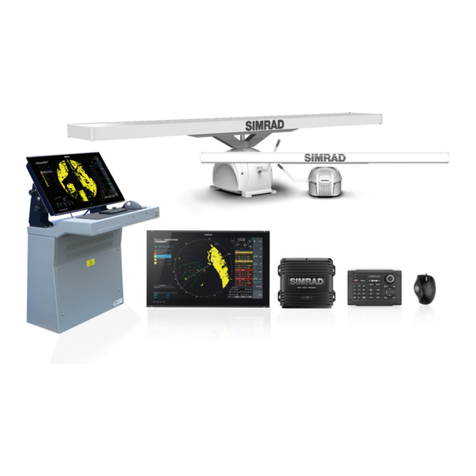
Simrad
Simrad R5000 Commissioning manual
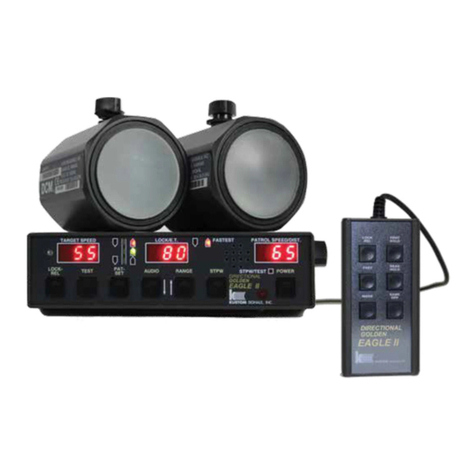
Kustom Signals
Kustom Signals Directional Golden Eagle II Operator's manual

Endress+Hauser
Endress+Hauser HART Micropilot S FMR533 operating instructions

Endress+Hauser
Endress+Hauser Micropilot FMR10 operating instructions
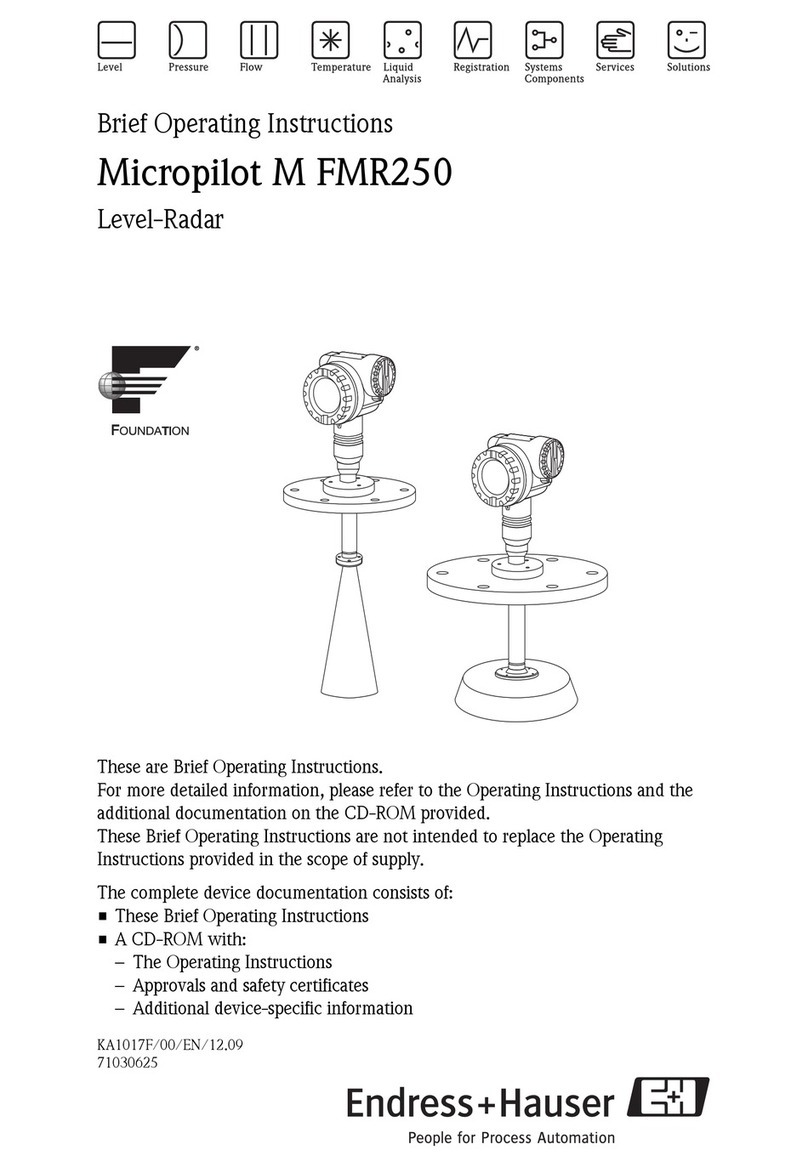
Endress+Hauser
Endress+Hauser Micropilot M FMR250 Brief operating instructions
